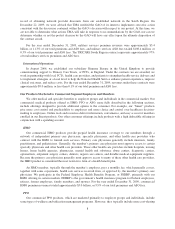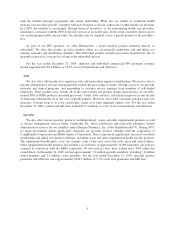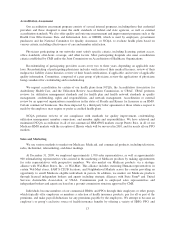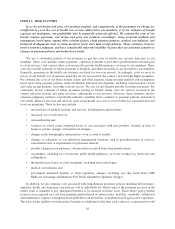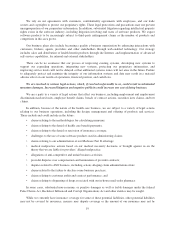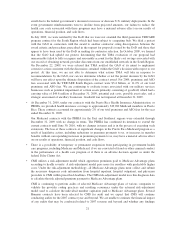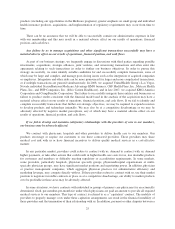Humana 2009 Annual Report Download - page 27
Download and view the complete annual report
Please find page 27 of the 2009 Humana annual report below. You can navigate through the pages in the report by either clicking on the pages listed below, or by using the keyword search tool below to find specific information within the annual report.only change if our experience deteriorates to the point the level of the liability is not adequate to provide for
future policy benefits. Future policy benefits payable include $571.9 million at December 31, 2009 associated
with a closed block of long-term care policies acquired in connection with the November 30, 2007 KMG
acquisition. Long-term care policies provide for long-duration coverage and, therefore, our actual claims
experience will emerge many years after assumptions have been established. The risk of a deviation of the actual
morbidity and mortality rates from those assumed in our reserves are particularly significant to our closed block
of long-term care policies. We monitor the loss experience of these long-term care policies, and, when necessary,
apply for premium rate increases through a regulatory filing and approval process in the jurisdictions in which
such products were sold. We filed and received approval for certain state premium rate increases in 2009 and
continue to expect to file for premium rate increases for additional states in 2010. However, to the extent
premium rate increases or loss experience vary from our acquisition date assumptions, future adjustments to
reserves could be required.
Failure to adequately price our products or estimate sufficient benefits payable or future policy benefits
payable may result in a material adverse effect on our results of operations, financial position, and cash flows.
We are in a highly competitive industry. Some of our competitors are more established in the health care
industry in terms of a larger market share and have greater financial resources than we do in some markets. In
addition, other companies may enter our markets in the future, including emerging competitors in the Medicare
program as well as in Smart products and other consumer health plans, such as high deductible health plans with
Health Savings Accounts (HSAs). We believe that barriers to entry in our markets are not substantial, so the
addition of new competitors can occur relatively easily, and customers enjoy significant flexibility in moving
between competitors. Contracts for the sale of commercial products are generally bid upon or renewed annually.
While health plans compete on the basis of many factors, including service and the quality and depth of provider
networks, we expect that price will continue to be a significant basis of competition. In addition to the challenge
of controlling health care costs, we face intense competitive pressure to contain premium prices. Factors such as
business consolidations, strategic alliances, legislative reform and marketing practices create pressure to contain
premium price increases, despite being faced with increasing medical costs.
Premium increases, introduction of new product designs, and our relationships with our providers in various
markets, among other issues, could also affect our membership levels. Other actions that could affect
membership levels include our possible exit from or entrance into Medicare or Commercial markets, or the
termination of a large contract, including the possible termination of our TRICARE contract.
If we do not compete effectively in our markets, if we set rates too high or too low in highly competitive
markets to keep or increase our market share, if membership does not increase as we expect, if membership
declines, or if we lose accounts with favorable medical cost experience while retaining or increasing membership
in accounts with unfavorable medical cost experience, our results of operations, financial position, and cash
flows may be materially adversely affected.
If we fail to effectively implement our operational and strategic initiatives, including our Medicare
initiatives, our business may be materially adversely affected, which is of particular importance given the
concentration of our revenues in the Medicare business.
Our future performance depends in large part upon our management team’s ability to execute our strategy to
position us for the future. This strategy includes opportunities created by the expansion of our Medicare
programs, including our HMO and PPO, as well as our stand-alone PDP products. We have made substantial
investments in the Medicare program to enhance our ability to participate in these programs. The expansion of
our provider networks and our success in attracting members to our network-based products positions us well for
changes in the Medicare program that will effectively eliminate the non-network PFFS plan option in 2011,
although there can be no assurances that our PFFS members will choose to move to our network-based products.
We are continuing to implement various operational and strategic initiatives, including further developing our
17



